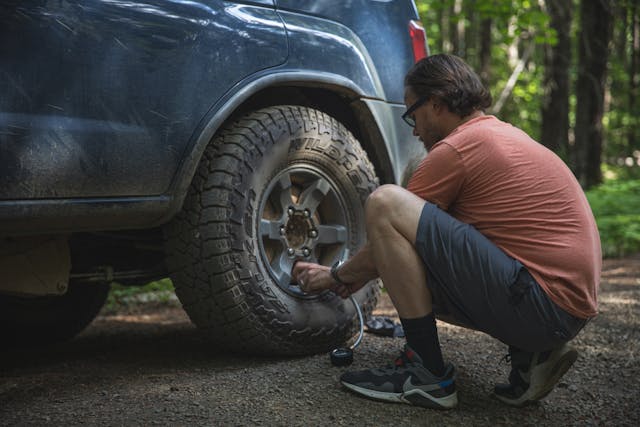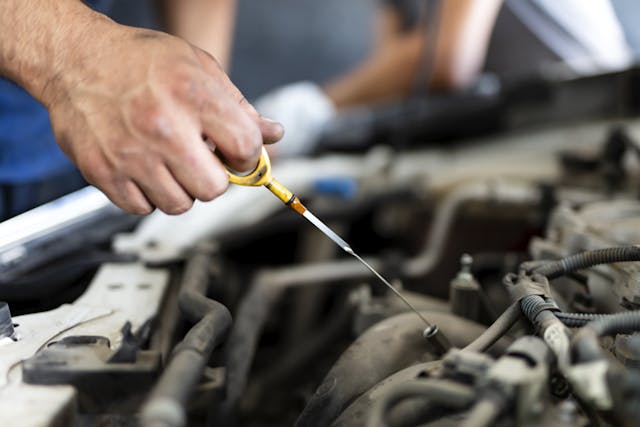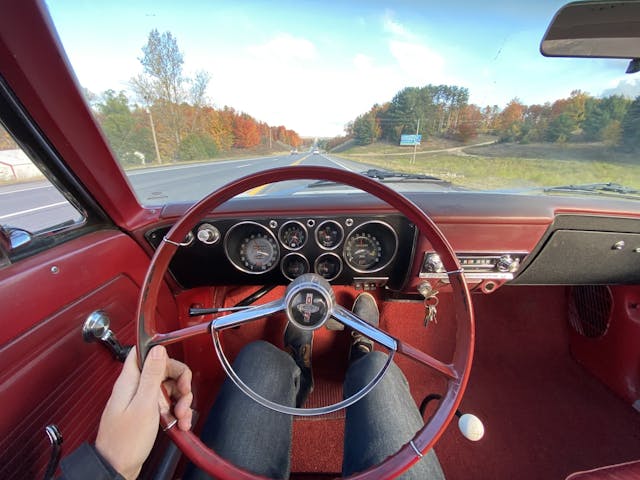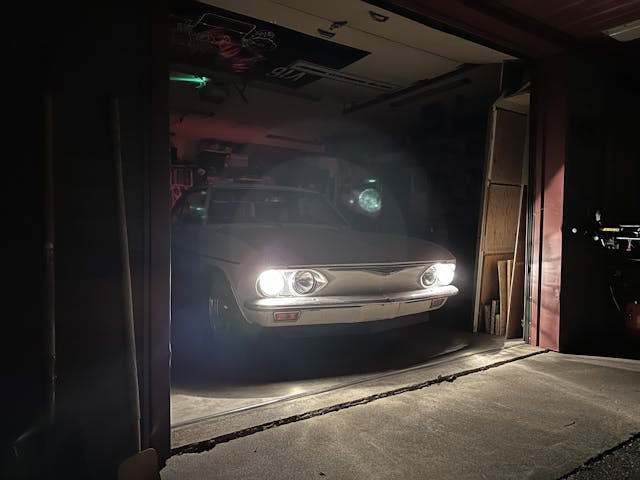Media | Articles
Before Driving Your Vintage Car, Check These 6 Things
Getting out on the road and enjoying our vintage cars is the majority of the reason most of us own them. Driving is what it’s all about, but driving safely is always the best plan. Many vintage cars now have spent time with owners who may not have been born when their car was built; if you find yourself in that camp, you may still be learning the day-to-day and year-to-year upkeep of your vehicle. Let’s take a look at a few checks and pre-drive rituals that will keep you and your old car happy for many miles to come.
Most owners and drivers of aging cars are diligent about inspecting them, but usually only once—when they buy the vehicle. After the purchase, most slip into the assumption that “it was fine when I parked it,” which can lull you into thinking everything is—and will remain—fine. Oftentimes everything is fine, but when a critical component or system isn’t, you can put more just yourself at risk. That’s worst-case scenario, of course; at a minimum, making a habit of regular quick inspections can save a lot of frustration and towing charges.
Marketplace
Buy and sell classics with confidence
Tires: Pressure and Condition

Tires are the only actual items that connect your multi-thousand-pound car to the road. We rely on those round rubber rings to not only grip the road surface but also to support the car. Having incorrect air pressure in the tires can produce unexpected changes in handling, cause a tire to build up heat and cause a blowout, or wear parts of the tire that aren’t designed to come in contact with the road.
Even a quick look while walking around the car is better than nothing, but make sure to check the pressure with a trusty gauge and look closer at the condition of the tread and sidewall. If you find an issue, that weekend drive you planned might get ruined, but that’s a whole lot better than finding the problem while going 55 mph and ruining a whole lot more.
Oil: Leaks, Level, and Condition

Engines live and die by the lubricants and other fluids contained within the block and heads. Just having enough oil and coolant will keep an engine alive far longer than some might think. Having clean and properly spec’d fluids will make a car run even longer and even better.
Taking a minute to pop the hood and pull the dipstick to confirm your car’s engine has the proper amount of oil is the bare minimum. Have a clean rag handy to wipe the dipstick clean and quickly inspect the oil for debris and color. A light amber is ideal, but tired engines can put a lot of combustion byproducts into oil relatively quickly, and those will turn oil darker. While you are thinking about fluids, take a peek under the car to confirm the oil leaks you might have did not get worse.
Steering: Is There Play?

A lot of people will say that old cars just have loose steering, but those people are only partially right. Vintage steering systems can feel less direct than modern designs but they should still be snug. Motion at the wheels should translate to motion at the front tires. After sliding into the driver’s seat, take a moment to observe the steering before starting the engine. This will help get an honest feel without the assistance of a power-steering pump, if your car is so equipped.
Lights

“How could anyone not notice a car as cool as mine?” We’ve all thought this while driving down the road, surrounded by homogeneous modern crossovers. The reality is a lot of drivers don’t care about vintage cars, and they have grown to expect vehicles to show daytime running lights, which vintage cars rarely have. An older vehicle can sneak up on many a modern driver, especially at dusk or in the early morning—you know, the best driving times.
That’s why it’s a good idea to do a quick walkaround or mirror check of the lights on all four corners of your car. Do your turn signals work? Has a bulb burned out? I like to turn on the lights of my Corvair before I open the garage door to see whether the headlights and turn signals work. I’ll also check the taillights—brake and running lights—in the rearview mirror, to see if they light up the back wall of the garage easily.
Brakes

Brakes, especially drum brakes, are notoriously difficult to inspect without some disassembly. One way I like to evaluate them is the hard/harder test. Before starting the engine, I push on the brake pedal with the force of a regular stop, such as I’d use when approaching a four-way stop, and hold that pressure for a moment to confirm the pedal does not sink further. After a short hold I then press harder, to mimic a panic stop, and again hold for a moment to ensure the system holds the pressure firm. I then release the pedal and ensure it returns to its correct position quickly and smoothly.
This works for both mechanical and hydraulic systems. Combine this simple test with a visual inspection of brake fluid level and condition, and you’ll have that much more peace of mind.
Throttle: Does It Stick?

The throttle is really fun to push, but more important than anything is the throttle’s return. Stuck throttles lead to bad situations. Before starting the engine, give the throttle a bump from fully closed to wide open and make sure it snaps shut quickly and without any binding. Many vintage cars use mechanical linkages or cables that can corrode or get grime in them which can slowly build up and cause problems. Best to catch such a problem while still in the garage or driveway.










This maybe applies more to a vehicle that’s been sitting for awhile, but I also like to check the exhaust – by holding a hand over the pipe(s) to feel the pressure while it’s idling. This is to tell me that something hasn’t crawled up in there while the car was parked. It also might tell me if some liquids are in there that shouldn’t be. I helped a friend start up his t-bucket a few days ago. It had been sitting for several months, waiting for a custom part to be sourced and delivered. The first thing I did after it fired was to walk around both sides and hold my palm close to the side pipes. One felt plugged, and sure enough, we found a mouse nest up where the headers collected.
Brakes. As a teacher once told us. No matter how good your car runs if it won’t stop it does you no good to drive it.
Correct me if I’m wrong, but I believe Brakes are the fifth thing on Kyle’s list of six things to check…
He knows that. He is just putting some emphasis on the subject. Jeez
“You said ‘brakes’ twice.”
“I know. I like brakes.”
An Evil Roy Slade reference, nice.
I have heard it said that a comptent driber needs no brakes.
I don’t know what a “Driber” is–but that Might be a good description for drivers who think they can drive with No Brakes-
“B” and “V” are next to each other on a standard QWERTY keyboard-get a life!
I remember seeing a nicely shaved pickup truck with a bashed in front and a bumper sticker that read “Brakes are for pu**ies.”
Brakes. Or horn. Or just don’t drive faster than you intend to hit anything.
Remember with older cars they need to be greased. That is with a grease gun, you have one, don’t you?
Jack up, pull the wheels, grease front suspension, steering rack, drive shaft and everything else that needs it.
I’m not sure about newer 1980 and later.
How many service stations now how
do a grease job, not many.
I have found that I don’t need to grease most of my collection terribly frequently largely due to the low miles I’m putting on them and the fact that I generally don’t drive them in inclement weather.
If you have a Corvette with that wonderful external power steering valve with the grease fitting on it (or anything similar) DO NOT GREASE IT.
While you are under there greasing the ball joints and checking the tires- there are a couple of more things. 1. Look around- not to gaze in wonder at the underside of the car but to look for loose or missing bolts, broken brackets or hangers or other “dangerous stuff”. An exhaust hanger that fails is not the end of your trip (provided that you have the universal bailing wire ready to go) but can be a pain to fix on the side of the road- if you brought a jack and jack stand with you- you didn’t!- then you are in a world of hurt trying to squeeze under a low car on the side of the highway with traffic and distracted drivers feet from you and your precious machine! A missing suspension bolt is something altogether more serious. I like to check tightness and paint mark critical bolts and nuts so there is an easy visual reference to see if they have moved. 2. Don’t ignore the universal joints or rubber drive shaft couplers, transmission mounts that are greased by that leaking gearbox or the sway bar or shock absorber rubbers- all of which can perish with age. I personally hate the newer polyurethane bushings- they become brittle and literally disappear. Had a recent one where I did some brake work- went out to drive the car and got a lot of front end “clunking”- was shock bushings (poly again) that had gone south- next thing to fix. 3. Don’t plan a big trip without first driving the car 50 miles out and 50 back. Lot easier to find any lingering issue before you are on the road for hours.
This is a critical item for me. My ’65 Volvo 544 shows 19! spots to grease on its chart. Maybe 16 or 17 now as through the years a couple of Zerk fittings have been eliminated on the driveshaft (4 fittings when new, including sliding trunion at the center hanger). Crucial though are the kingpin fittings. I’ve replaced them twice in the 54 years I have owned the car and don’t ever want to do them again! We have to remember some of these old cars had a 1500 mile greasing interval. I think Ford was one of the first to go with greaseless joints, around ’63 or ’64. Correct me if I am wrong.
Yes 60’s fords came with no fittings however you could remove the plug and put a fitting in after warranty of course
I had an ’07 Silverado 1500 – first new vehicle I ever bought in my life (and the last!). Only greaseable parts of the front end were the tie rod ends on the rack and pinion (no inners). The lower ball joints started to get sloppy at 38k miles, and the uppers were smoked by 50k. Thank GM for saving .10 cents on a grease fitting and cutting some channels in the ball.
Now everything I own and drive was built in the 20th century, and I couldn’t be happier. More time driving them than working on them for a change!
Is there gas in it?
Did I finish putting it together after my last round of tinkering?
Along the lines of DUB’s comment… Did a rodent build a nest in the air cleaner? Not that I let my toys sit long, but I had a 944 with an intake snorkel that was just a little too attractive for little critters. If that thing sat more than a week or so I had a fairly high likelihood of finding the starts of a rodent nest (and maybe the little bugger itself) in the air cleaner
And TG’s “Did I finish putting it together after my last round of tinkering?” brought another thought to my mind (based on actual experience). If you plug into a battery minder of some sort, remember to unhook it and ensure the hood is latched before you fire ol’ Betsy up and back out of the garage. If you forget, the first thing you may do is rip the cord right out of the tender, and second, when you get up to speed, you may indeed have your hood fly up and wreck the hinges (among other damage).
Did that once while starting to back out of the driveway in a car that’s not driven often. Caught it in time, but now there’s a note in the dash stating “remove battery tender”.
Along the lines of vintage cars not being conspicuous to regular drivers, I also have installed a CHMSL, or third brake light, in the Road Runner. Most drivers these days expect to see one, so I suspect that regular brake lights are less conspicuous in comparison. It was out of a ’84 Maxima, when manufacturers were not exactly designing these things in from the get-go, so it’s held in place on a plate that is wedged between package tray cover and backlight lower interior trim piece. Painted to match the interior (dark green, big surprise), it looks like it belongs there on top of the package tray, pretty much. The non-factoryness of it is a trade-off I can tolerate for the possible safety enhancement.
yup, did the same myself. went so far as to get the cord caught under the tire. slightly embarrassing (don’t tell anyone)
since that minor altercation, i leave the hood up. kinda hard not to notice that.
Any time I have the battery minder hooked up-The Hood is raised–
I added a connector to the battery tender cable (very little current, so all you really need is to make sure the poarity is maintained) I connect to my 79 VW Super Beetle. With the battery under the back seat, the cable is bolted to the battery and the connector is tucked between the seat and the side panel.
With the power cord and tender sitting on the convertible top, it’s pretty obvious. So far, so good.
I’m wondering about gasoline. My SC430 sits in the garage for many weeks at a time between joyrides. Thinking about adding a fuel stabilizer. I keep a trickle charger on it.
In my experience, weeks is fine. Months are also fine. Years is when it becomes a problem.
I would agree with that. And if it’s approaching a year old, you need to get out more!
My general philosophy is if I hop in it and the battery is dead, I’m not driving it enough… or I have too many. I don’t use battery tenders.
Use tenders, problem solved. 🙂
Battery tenders seem to be a requirement for cars not frequently driven that have car alarms or some other slow battery draining tech.
When I put my 1969 MGB away for the winter, I have the battery pulled. Re-charged in the Spring
Me too. On my 1998 MGF.
Most cars 1981 or newer have a computer that will drain the battery if not driven. Some high dollar cars (caillac etc} might have had one earlier
Anything with a computer, they’re required. I used to have an ’07 Silverado 1500 – whenever it sat more than a couple weeks, even a brand new battery would barely crank the engine. Our ’86 Grand Marquis and 2 Volvo 940’s have computers too, but the draw isn’t an EIGHTH of what modern vehicles draw, key off.
I use battery tenders on everything I have, including the Deere tractor and ZT mower. My batteries last a long time and are always up for a start. I regularly get 12 years or longer battery life in a car. Highly recommend them.
I haven’t had to put a new battery on the JD since I started using a battery tender, so it is paid for. With the tractor, the Gator and one of our trucks it’s possible to drape the tender across the controls in such a way that you just couldn’t be that stupid. Works so far!
I plug my battery tender into the cigarette lighter socket and route the power for it through the driver’s door opening. Wasn’t too hard to put a new plug on the tender.
Just unplug the battery cables no tender needed.
You need to rethink that .If you live in a cold climate and disconnect the battery during winter storage- expect a dead battery in the spring. Even one that won’t hold a charge. A tender prevents all that
Actually, cold climates are beneficial to battery life, so long as they are stored fully charged and can’t freeze. In colder temps, the natural loss of voltage is slowed – same reason they crank engines over so slow in the cold. If you’re storing something all summer long is when you need to be on top of that battery as far as maintenance. Like a battery in a yard horse plow truck, or heavy equipment you don’t use every day.
In Phoenix AZ, the average battery life is 3 years. Up here in MA, I regularly get 11-12 years out of batteries without much issue. Heat is a killer.
i’m fortunate to have non-ethanol fuel available locally – regular, mid-grade, and premium. although not a cure-all, it is much better for longer term storage than “up to 10%” fuels.
i probably own over a dozen battery maintainers, using almost every one currently. i’m an advocate like many others, but don’t think they’re necessary in all situations
First off, I fill the tank with Non Ethanol gas, and as a second step I put about a quart of Sea Foam in the tank, and to date, knock on wood, the ’38 starts right up.
/|\ all of the above – plus if fallow very long, check belts, fluids including oil, brake, powersteering + antifreeze, also radiator + hoses. battery, cables + starter, (consider taking a jumper pack). check spare tire, jack, lug wrench, plus loose + retighten lug nuts (as they may be rusted on). spare keys. have enuf fuel and check all gauges + warning lights after iding. cell phone. AAA card + $. registration papers, license plates + whatelse ever you might get stopped for. pencil + paper in case you need to leave a note on car. tell somebody you’re going, maybe bring someone along. good walking shoes, cool shades, Hagerty hat, maybe a coat. BR. look under car, then drive around the block once, before setting off your onroad trip.
Bank account
Something that should be checked regularly even if you’re NOT going out in your vintage car! 🙄
What year does “Vintage” start?
I change my oil and filter yearly. I probably drive 500 to 800 miles a year but I still do it. The oil is always clean but I recycle it. Also grease the fittings and wipe them off. I have about 10 ot 12 on the car. My tires are about 10 years old so I might change them this year. They are in the garage out of the sun unless I take it out for a ride. The coolant is due this coming spring so I will flush and change it. I see a little weeping near the lower rad hose so it needs some investigation. Either a hose or maybe the radiator, I’ll find out. There is always something to worry about. The transmission fluid is a perfect color and always up to the full mark. Oh yes, new brakes and rear cylinders with new fluid and shocks all around last year. Always something.
I just replaced my 30 year old BF goodriches on my cuda.they looked like new but I was tired of getting crap from fellow car enthusiasts.
I second this. It might surprise you to learn how old the tires on your classic are. I know the tread looks great because you don’t drive it much. But check the date code on your tires (easy to find out where it is and how to read it on the Internet.) You may be surprised when you learn your tires are a lot older than is safe. The last thing you need is a blowout.
Jay Leno wrote a column about a tire blowing out in his garage. Plenty of tread, but old rubber is old rubber.
Some years ago, the kid next door bought a beautifully maintained Cutlass from a older neighbor. Shortly thereafter, a tire blew, causing body damage. The tread was sufficient, but they were just too old.
Always restock zip ties, a pickaxe and sodium hydroxide.
Oh, right along with disconnecting the battery tender, close the hood (er bonnet ) and the trunk (er boot ) before you back out of the garage and rip something off on the overhead door you just opened !
I’m surprised ‘check for fuel leaks’ is not in the article. Brakes and fuels leaks are the two leading cause of disasters based on my observation, thankfully not experience. You did include another highly important ‘check tires’, I was glad to see that in the article.
Item #6 is very important! Riding with a friend in a dubiously maintained BMW2002 decades ago, he stomped the gas to pass a very slow moving vehicle, only to have the throttle stick wide open. I, in the passenger seat became very quickly alarmed. He, driving in bare feet (dumb), pulled back on the pedal with his prehensile toes- only to have the linkage disconnect! The final part of Mr Toads Wild Ride was his decision at that point in a rapidly accelerating car to put the clutch in. Reduced the acceleration to nothing, as well as the clutch and bell housing to pieces just like the old AMCO ad.
Lots of lessons here for the taking. “Don’t drive like that!” being high on the list. Keep the car maintained (though we were both flat broke early 20-somethings). Brakes beat engine in almost all circumstances, in retrospect, the right off-ramp to a bad situation. Front disks would have overwhelmed the 2L engine, even in 2nd gear well enough to allow for a better outcome than collecting shattered transmission pieces from the road.
The ignition key might have helped. A shut-off engine is unlikely to blow up a clutch.
Yeah, a few days late and a few dollars short, bit if there’s ever a next time…
The throttle linkage on my 67 XKE would get pushed to wide open throttle because the motor mounts were bad and the torque of the engine would cause rotation and push the throttle the rest of the way open and then pin the linkage between the engine and the frame. I have to say, the three or four times that happened always ended up being memorable.
Always inspect fuel lines and make sure you have a fire extinguisher with you.
a payed up triple A card or some other towing card with enough distance for your proposed trip
Don’t you have towing w/ Hagerty?
Yes, check underneath the vehicle for fluids. Take it a ‘step’ further, put some ‘clean’ cardboard under the car – it will catch leaks, and even if they dry-up, there will be corresponding stains where the drip hit it.
A side benefit to that, it helps prevent the floor from being stained.